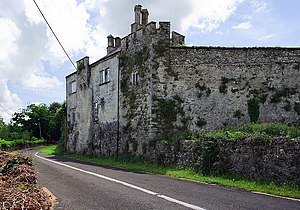Croom Castle
The territory in which Croom lies was up until the period of the Norman invasion of Ireland the domain of the ancient Uí Cairpre Áebda (Cairbre Eva), of whom the O'Donovans were the leading family.
[3] In this instance, an O'Donovan ancestor, Uaithne mac Cathail (circa 960 a.d.), is mentioned and associated with Cromadgh, the spelling for Croom in use in the mid-12th century.
[citation needed] Some O'Donovan oral traditions note that the O'Donovans of Carbery are descended from Crom Ua Donnabáin (died 1254), noted in annals as Ancrom, or "The Bent", and also associate him with the building of the Castle of Croom,[4] but this association of Ancrom with the Castle of Croom based on the similarities in name and spelling has been discredited repeatedly.
They came hither from Coshma, in the County of Limerick, and built there the famous Castle of Crome, which, afterwards, falling to the Earl of Kildare, gave him his motto of "Crome aboo," still used on his skutcheon.One branch of the O'Donovans and a remnant of the UI-Fidgheinte has been resident in Croom almost continuously for more than eight centuries, with their current farm being held for more than four centuries, but have not occupied the tower castle since the Earls of Kildare established their residence there.
One such attack was noted in 1151, when a great predatory excursion was made by Ruaidhri, son of Toirdhealbhach Ua Conchobhair, into Thomond, and he carried away many cows, and burned Cromadh.
